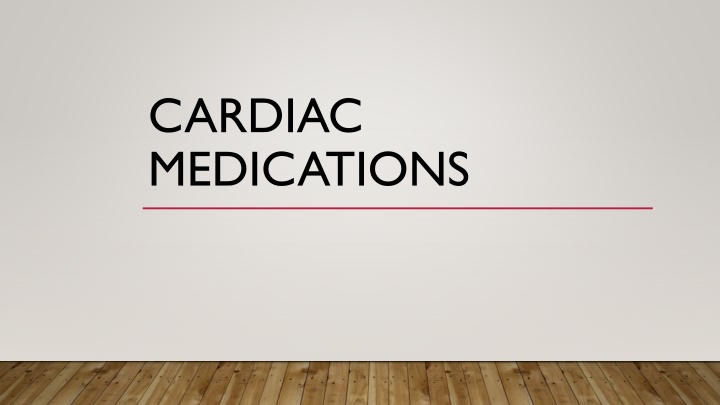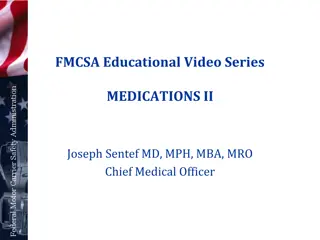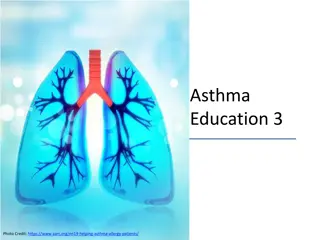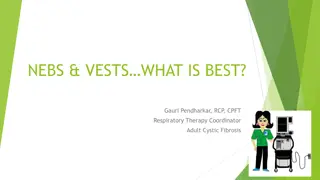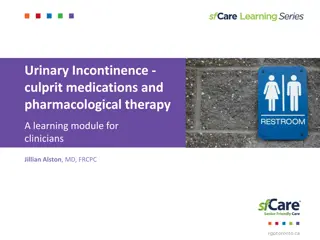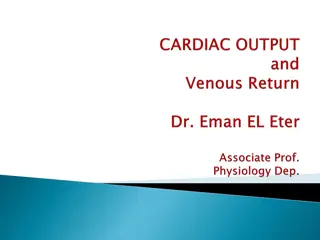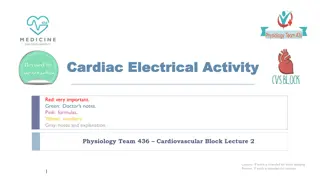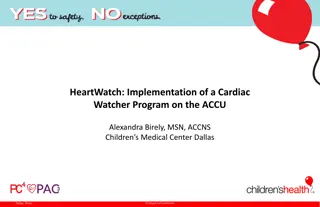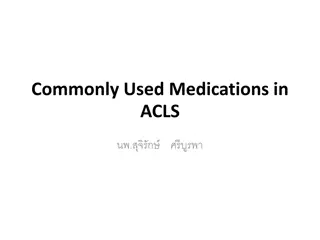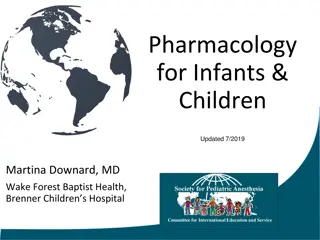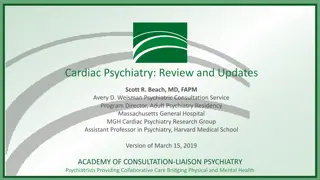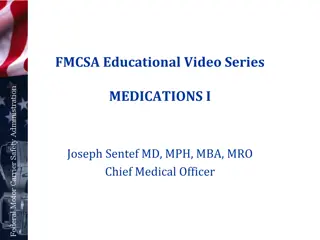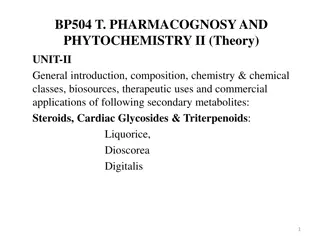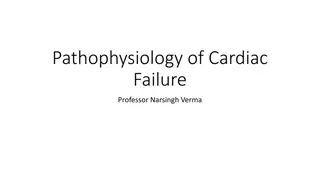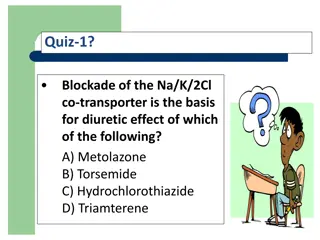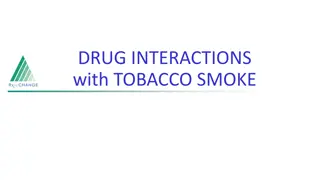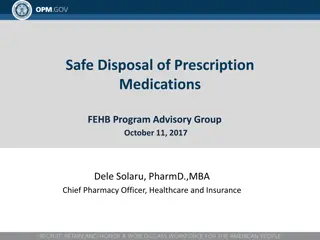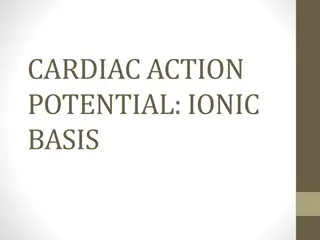Overview of Cardiac Medications and Their Effects
This comprehensive guide covers various types of cardiac medications including anticoagulants, antiplatelet drugs, thrombolytics, and beta-blockers. It details their mechanisms of action, dosage guidelines, side effects, and contraindications. Anticoagulants prevent blood clotting, antiplatelets inhibit platelet aggregation, thrombolytics dissolve blood clots, and beta-blockers regulate heart function. Each class of medication has specific considerations and potential risks, making it essential for healthcare providers to carefully prescribe them based on individual patient needs and medical history.
Download Presentation

Please find below an Image/Link to download the presentation.
The content on the website is provided AS IS for your information and personal use only. It may not be sold, licensed, or shared on other websites without obtaining consent from the author.If you encounter any issues during the download, it is possible that the publisher has removed the file from their server.
You are allowed to download the files provided on this website for personal or commercial use, subject to the condition that they are used lawfully. All files are the property of their respective owners.
The content on the website is provided AS IS for your information and personal use only. It may not be sold, licensed, or shared on other websites without obtaining consent from the author.
E N D
Presentation Transcript
CARDIAC MEDICATIONS
ANTICOAGULANTS Activation of anticlotting factors (especially antithrombin III), direct inhibition of thrombin, inhibition of synthesis of blood coagulation factor precursors (zymogens), and activation of protein C. 300 to 650 mg orally every 4 to 6 hours as needed Maximum dose: 4 g in 24 hours
SIDE EFFECTS Excessive bleeding Hair loss Digestive tract disorders
CONTRAINDICATIONS No treatments with anticoagulants plants should be made in the following cases: -pregnancy and lactation Problems of coagulation such as haemophilia, thrombocytopenia or lack of platelets -people with regular nosebleed and bruising -before or after surgery
ANTIPLATELET Antiplatelet drugs are used for prophylactic and/or long-term anticlotting treatment. As with thrombolytic and anticoagulant drugs, their major side effect is BLEEDING. Percutaneous coronary intervention (PCI). For people with ACS who are undergoing PCI, aspirin (75 100 mg) in combination with one of the following antiplatelet is initiated in secondary care: Prasugrel 10 mg daily (or 5 mg daily if the person weighs less than 60 kg, or if the person is 75 years of age or older). Ticagrelor 90 mg twice a day.
SIDE EFFECTS Nausea Stomach upset Nosebleed Heavy bleeding from cuts Blood in urine or stool
THROMBOLYTIC Thrombolytic drugs dissolve blood clots by activating plasminogen, which forms a cleaved product called plasmin. Plasmin is a proteolytic enzyme that is capable of breaking cross-links between fibrin molecules, which provide the structural integrity of blood clots. Because of these actions, thrombolytic drugs are also called "plasminogen activators" and "fibrinolytic drugs." There are three major classes of fibrinolytic drugs: tissue plasminogen activator (tPA), streptokinase (SK), and urokinase (UK). While drugs in these three classes all have the ability to effectively dissolve blood clots, they differ in their detailed mechanisms in ways that alter their selectivity for fibrin clots. In a subset analysis of IVT patients, total doses ranged from 48.2 to 149 mg and were not associated with either symptomatic (p = 0.23) or asymptomatic (p = 0.24) ICHs.
BETA BLOCKERS Beta-blockers, in addition to their sympatholytic 1 activity in the heart, influence the renin angiotensin system at the kidneys. Beta-blockers cause a decrease in renin secretion, which in turn reduces the heart oxygen demand by lowering the extracellular volume and increasing the oxygen-carrying capacity of the blood. Initially, prescribe 400 mg daily in up to two divided doses. If necessary, increase doses at an interval of two weeks.The maximum dose is 1.2 g daily.
SIDE EFFECTS Difficulty breathing. Beta-blockers can cause lung muscle spasms that make it difficult to breathe. This is more common in people who have lung conditions. High blood sugar (hyperglycaemia). Beta-blockers can trigger high blood sugar in people with diabetes. Depression, insomnia, and nightmares. These side effects are more common with older, nonselective beta-blockers
ACE-INHIBITOR/ANGIOTENSIN RECEPTOR BLOCKER The exact mechanism of ACE inhibitors is not fully known. They do interfere with the renin-angiotensin-aldosterone system, but their effect is not directly related to renin levels in the blood. ACE inhibitors, as the name implies, blocks an angiotensin-converting enzyme that converts angiotensin I to angiotensin II. All of the ACE inhibitors are prescribed orally, except for enalapril, which can be given intravenously. The dosage is 1.25 mg every 6 hours. It can be increased to 5 mg every 6 hours. There should be a dosage decrease in patients with heart failure, salt-depleted patients, and/or renal impairment.
SIDE EFFECTS A dry persistent cough Blurred vision Dizziness Dry mouth or loss of taste in the mouth Fatigue
LIPID-LOWERING AGENTS The main mechanism responsible for the cholesterol lowering effect of free and esterified plant sterols is the inhibition of intestinal cholesterol absorption. Several sites within the intestinal tract have been suggested where this inhibition might take place. 1200 mg per day (usually given as 600 mg twice daily by mouth).
CALCIUM-CHANNEL BLOCKERS Mechanism of Action. Calcium channel antagonists block the inward movement of calcium by binding to the L-type long-acting voltage-gated calcium channels in the heart, vascular smooth muscle, and pancreas. There are two major categories of calcium channel antagonists based on their primary physiologic effects. The standard starting dose is 240 mg once a day. For people new to verapamil therapy, consider halving the initial dose to 120 mg. The maximum dose is 240 mg twice a day (doses spaced by an interval of 12 hours).
DIGITALIS Mechanisms of action Digitalis compounds are potent inhibitors of cellular Na + /K + -ATPase. This ion transport system moves sodium ions out of the cell and brings potassium ions into the cell. Digitalis leaf has a narrow therapeutic index, requiring close medical supervision for safe use. Traditional dosage starts at 1.5 g of leaf divided into 2 daily doses. Purified digoxin is typically used at daily doses of 0.125 to 0.25 mg.
ANTI-ARRHYTHMIC A diuretic is a substance that increases the rate of urine volume output, as the name implies. Most diuretics also increase urinary excretion of solutes, especially sodium and chloride. In fact, most diuretics that are used clin-ically act by decreasing the rate of sodium reabsorption from the tubules, which causes natriuresis (increased sodium output), which in turn causes diuresis (increased water output). That is, in most cases, increased water output occurs secondary to inhibition of tubular sodium reabsorption, because sodium remaining in the tubules acts osmotically to decrease water reabsorption. Because the renal tubular reabsorption of many solutes, such as potassium, chloride, magnesium, and calcium, is also influenced sec-ondarily by sodium reabsorption, many diuretics raise renal output of these solutes as well. The most common clinical use of diuretics is to reduce extracellular fluid volume, especially in diseases associated with edema and hypertension. As discussed, loss of sodium from the body mainly decreases extracellular fluid volume; therefore, diuretics are most often administered in clinical conditions in which extracellular fluid volume is expanded. If we use diuretics typical doses are: furosemide 1 mg/kg thiazide 1 - 2 mg/kg in 1 or 2 dose (s) a day spironolactone 1 -2 mg/kg in 1 or 2 dose (s) a day.
DIURETICS A diuretic is a substance that increases the rate of urine volume output, as the name implies. Most diuretics also increase urinary excretion of solutes, especially sodium and chloride. In fact, most diuretics that are used clin-ically act by decreasing the rate of sodium reabsorption from the tubules, which causes natriuresis (increased sodium output), which in turn causes diuresis (increased water output). That is, in most cases, increased water output occurs secondary to inhibition of tubular sodium reabsorption, because sodium remaining in the tubules acts osmotically to decrease water reabsorption. Because the renal tubular reabsorption of many solutes, such as potassium, chloride, magnesium, and calcium, is also influenced sec-ondarily by sodium reabsorption, many diuretics raise renal output of these solutes as well. The most common clinical use of diuretics is to reduce extracellular fluid volume, especially in diseases associated with edema and hypertension. As discussed, loss of sodium from the body mainly decreases extracellular fluid volume; therefore, diuretics are most often administered in clinical conditions in which extracellular fluid volume is expanded. If we use diuretics typical doses are: furosemide 1 mg/kg thiazide 1 - 2 mg/kg in 1 or 2 dose (s) a day spironolactone 1 -2 mg/kg in 1 or 2 dose (s) a day.
NITRATES Mechanism of action of nitrates: Nitrates get metabolised to form nitric oxide, which is a potent vasodilator. Nitric oxide is also the endothelium derived relaxing factor. Nitric oxide stimulates the enzyme guanylate cyclase, which causes the synthesis of cyclic guanosine monophosphate (cGMP). For oral dosage form (extended-release capsules): Adults 2.5 to 6.5 milligrams (mg) 3 to 4 times a day. Your doctor may increase your dose as needed. Children Use and dose must be determined by your doctor.
OXYGEN Oxygen therapy increases the arterial pressure of oxygen and is effective in improving gas exchange and oxygen delivery to tissues, provided that there are functional alveolar units. a dose of 2 to 4 L/minute via nasal cannulate. These recommendations are not based on controlled clinical studies. No consensus exists among stroke physicians regarding how much oxygen should be administered and which route should be selected.
ANALGESICS An analgesic or painkiller is any member of the group of drugs used to achieve analgesia, relief from pain. Analgesic drugs act in various ways on the peripheral and central nervous systems. They are distinct from anaesthetics, which temporarily affect, and in some instances completely eliminate, sensation. The recommended analgesic dose of oral aspirin for mild-to-moderate pain in adults and children older than 16 years of age is: 300 900 mg every 4 to 6 hours as required (maximum 4 g in 24 hours
ANTIEMETICS Pharmacology and mechanism of action Antiemetic drug from the class of drugs called serotonin antagonists. These drugs act by inhibiting serotonin (5-HT, type 3) receptors. During chemotherapy, there may be 5-HT released from injury to the GI tract, which stimulates vomiting centrally. Total body irradiation 5-HT 3 Receptor Antagonistic Ondansetron 8 mg oral or 8 mg oral dissolving tablet, or 8 mg oral soluble film or 8 mg or 0.15 mg/kg IV Use as prophylactic therapy. Once daily to twice daily on days of radiation therapy, with first dose given.
